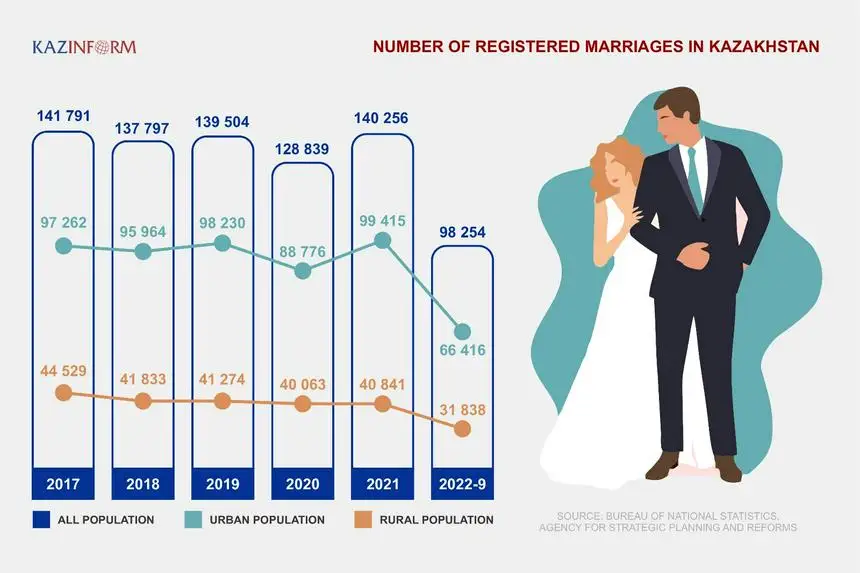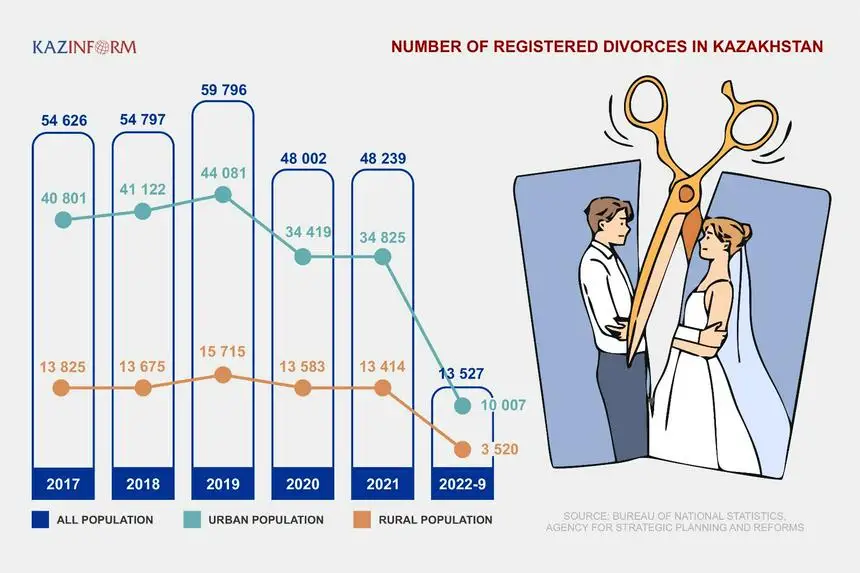Latest report reveals new data and trends on families in Kazakhstan

The last time a study like this was conducted was in 2020. The report, consisting of 4 chapters, presents the results of a survey among 1,200 respondents from 17 regions of the country.
«Most Kazakhstan’s citizens recognize the value of the family, but this institution is gradually beginning to change. It is being transformed in our country under the influence of several factors, not only internal but also external, which in the context of globalization is understandable. The current generation has more opportunities for self-realization than the previous one, young people want to get an education first, find a job and become economically independent,» said Olga Nikolaeva, Ph.D. in sociology and one of the authors of the report, in a comment for this story.

Declining marriage rates
One of the key takeaways from the report is the declining marriage rate over the past years across all regions. The highest number of registered marriages was in 2017 – 141,791; the lowest indicator was reported in 2020 - 128,839.

Marriage rates, however, were relatively higher in Almaty city, Almaty and Turkistan regions, and the city of Astana.
The lower marriage rates in 2020 are the result of the COVID-19 pandemic. In this case, the 7.6 percent decline in the marriage rate is attributed to factors such as the lockdown, a slowdown in government services and restrictions on wedding celebrations.
The declining marriage rates reflect a complex interplay of social, economic, and cultural factors.
People now have more alternative lifestyles available to them, such as cohabitation, civil marriage or remaining single. These alternatives are becoming more accepted, which may lead some people to choose them over marriage. In 2019, 2.9 percent of the respondents were in civil marriage, in comparison to 5.8 percent in 2022.
Economic factors are also important. In many countries, the cost of living is rising, and Kazakhstan is no exception, which makes people delay or forgo marriage due to financial concerns.
Social norms around marriage have also shifted over time, there is less pressure to get married or stay married. People are increasingly choosing to focus on their self-development, such as education and work.

The report indicates economic matters as the main factor behind low marriage rates in rural areas. There are nearly 6,500 villages with a population of 500 people and above, and they are significantly disadvantaged compared to cities, facing such problems as low employment and low incomes.
For comparison, in 2017, the marriage rate was 9,33 per 1,000 people in cities and 5,85 in rural areas. The gap narrowed by 2021, with 7,33 per 1,000 people in cities and 6,69 in rural areas.
Some 28.3 percent of respondents in the survey said they have a positive attitude about civil marriages, 33.1 percent are neutral, and 32.8 said their attitude is negative.
«As the survey data show, among the surveyed population, civil marriage is positively perceived by the age cohort from 29 to 60 years old. The adult generation of retirement or pre-retirement age has traditional attitudes toward the family. This generation perceives families when they are an official marriage. As a rule, the older generation is focused on traditional family values - it is marriage between a man and a woman, the choice of a partner from the endogamous group, and a complete family with a patriarchal orientation,» reads the report.
The decline in marriage rates, however, is common only in Kazakhstan. It is a global trend. In the United States, for example, the marriage rate in 2020 stood at 5.1 per 1,000 total population, according to the National Center for Health Statistics. There were 1,676,911 marriages registered in the United States, with a population of 329,484,123.
Another example is the European Union, where according to the latest data available from Eurostat, the marriage rate in the EU in 2020 was 3.2 marriages per 1,000 inhabitants.
Divorce rates are declining
At the same time, the report indicates that divorce rates are declining in Kazakhstan. On average, 140,000 families are registered nationwide each year, and 50,000 fall apart.

In 2017, Kazakhstan registered 54,626 divorces, which went down to 13,527 in nine months of 2022. The 2017 divorce coefficient was 3.03 per 1,000 of the population, and in 2021, it fell to 2.54 per 1,000 people. The highest divorce rate, according to 2021, was recorded in Astana, Pavlodar, Karaganda and North Kazakhstan regions.
The gap between urban and rural areas is also evident in divorce rates.
Since the early 2000s, the most common length of marriage among those who divorced or the most «vulnerable period» for married couples was the period from 5 to 9 years of life together, which invariably accounted for a higher proportion of divorces - up to 30 percent.

Since 2021, the trend has shifted. 29.2 percent of divorces happen between 1 to 4 years, and 26.3 percent of divorces happen between 5 to 9 years of marriage.
In the US, as a comparison, the divorce rate stands at 2.3 per 1,000 total population. In the European Union, the latest data from 2020 shows that an estimated 0.8 million divorces took place in 2020, or and 1.6 divorces for every 1,000 persons.
When asked what can justify a divorce, 61.7 percent indicated alcoholism or drug addiction of one of the spouses as a major reason. Domestic violence against a spouse or children was mentioned by 51.1 percent. 47 percent named infidelity, 38.4 percent named gambling, and 22 percent named «non-traditional sexual orientation of one of the spouses» as key reasons behind the divorce.
Baby boom in Kazakhstan
While more families in Kazakhstan are choosing to have children at a later stage of their lives, the data shows an increasing birth rate since the pandemic. One of the key reasons is that people had to stay at home due to coronavirus-related restrictions.
In recent years there has been a gradual increase in the total fertility rate, which refers to the number of children per woman of fertile age. At the end of 2021, the fertility rate stood at 3.32.
In terms of regions, the highest total fertility rate is observed in Turkistan (5.1), Mangystau (4.57), and Kyzylorda (4.36) regions, where there are more than five children per woman.
Northern regions of Kazakhstan tend to demonstrate lower fertility rates – North Kazakhstan region (1.97) and Kostanai region (1.88).
At the same time, the average age of having a first child among women is increasing from 24.6 years old in 2017 to 25.2 years old in 2021.

The data differs across regions. Southern and western regions are witnessing a decrease in the age of birth of the first child, in the Turkistan region – from 23 years in 2017 to 22.5 years in 2021, and in the Mangystau region – from 24.6 years in 2020 to 24.1 years in 2021.
On the contrary, women in bigger cities, such as Astana (from 26 years in 2017 to 27 years in 2021) and Almaty (from 26.9 years in 2017 to 28.1 years in 2021), tend to have their first child at a later age.
A baby boom can pose various risks and challenges for the country. It is an economic burden, especially if the country lacks the infrastructure, resources, and services to support the growing population, an additional load on healthcare, as more children will need access to medical care, vaccination, and other services, and notably, it is pressure on education system.
Kazakhstan already faces a shortage of schools. While the government is trying to address this problem by building more schools, hiring more teachers, and creating other conditions, it might not be enough to accommodate the growing population.
95 percent of respondents satisfied with their family relations
The survey indicates that 94.5 percent of respondents are satisfied with family relationships. At the same time, 4.7 percent of respondents are not satisfied with family life to a greater or lesser extent.
Respondents were asked questions about satisfaction with family relationships; values they want to instill in children; family traditions; spending time together; and the specifics of intergenerational interaction and parenting.
The survey reveals a correlation between the level of financial well-being and satisfaction with family life. Respondents with a relatively low level of income more often responded that they were not satisfied with family relations. 12.5 percent of respondents whose families do not have enough money to buy foodstuffs noted dissatisfaction with family life.
Among the key values that families seek to give their children are hard work (33.8 percent), self-respect (31.8 percent), honesty (31.7 percent), respect for elders (25.3 percent), and respect for others (16.6 percent).

Photo:zinasjekabpils.lv
Interestingly, over the years, some values have become less important for families - diligence (from 64.1 percent in 2020 to 33.8 percent in 2022), respect for elders (from 54.9 percent in 2020 to 25.3 percent in 2022), and love for motherland (from 16.4 percent to 7.1 percent in 2022).
Overall, the data shows that Kazakh families retain the traditional family structure, where the head of the family is a man, and housework is the responsibility of women, and both men and women think so.
Women spend time with children more often, men are more often responsible for the financial provision of the family. Women's work, as a rule, is not considered a significant contribution to the family budget.
Parenthood, however, is perceived by respondents as a shared responsibility.
Traditional gender roles perpetuate and exacerbate the challenges women face as they have to balance their work and household. Women’s contribution to families is often an «invisible load,» including mental and emotional.
Amplifying this problem is the fact that many employers, businesses, and organizations are not geared toward working mothers. This is a reality for at least 48.5 percent of women in Kazakhstan who are employed and combine work and motherhood.
«Family policy trends affect various aspects of family life: economic and social values. It is worth noting that significant attention is paid not only to socially vulnerable segments of the population but also to traditional types of families,» said Nikolaeva. «To enable parents to combine family responsibilities and employment, the labor legislation enshrines norms on the rights of parents to flexible forms of employment and leave to care for a child. Of course, the state in every way supports socially vulnerable citizens, providing everyone with opportunities, the only problem is that not everyone is aware of the existing state programs.»
The development of family policy in Kazakhstan has been a priority for the government, and various measures have been implemented to support families and children in the country, including maternity and childcare benefits, housing programs, and violence prevention programs. Yet, more must be done to ensure no one is left behind.
